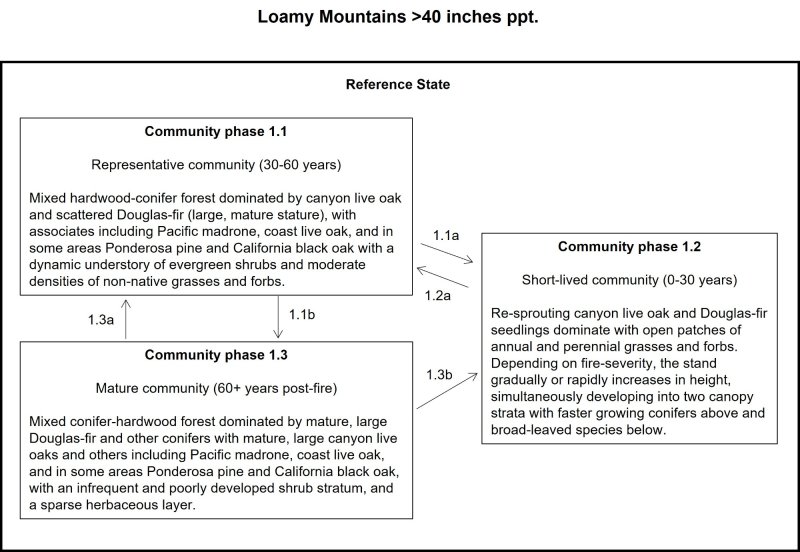Ecological site group F015XY015CAESG
Loamy Mountains >40" ppt
Last updated: 09/07/2023
Accessed: 12/22/2025
Ecological site group description
Key Characteristics
- located on mountains
- loamy texture
- >40" ppt
Provisional. A provisional ecological site description has undergone quality control and quality assurance review. It contains a working state and transition model and enough information to identify the ecological site.
Physiography
This ESG is typically found on mountain slopes from 10 to 75 percent. Elevations typically range from 500 to 5000 feet (can be up to 5700 ft in some areas).
Climate
The average annual precipitation in this area is at least 40 inches (1000 millimeters) and the areas at higher elevations can reach up to 88 inches (2235 millimeters). Snowfall is common in the northern half of the part north of San Francisco and rare elsewhere. Precipitation is evenly distributed throughout fall, winter, and spring but is very low in summer. Coastal areas receive some moisture from fog in summer. Most of the rainfall occurs as low- or moderate-intensity, Pacific frontal storms during the period October to May. The average annual temperature is 52 to 65 degrees F (11 to 18 degrees C), decreasing from south to north. The freeze-free period averages 275 days and ranges from 180 to 365 days, decreasing in length with elevation and from south to north.
Soil features
Soils in this ESG consist mainly of very shallow to moderately deep, well drained to somewhat excessively well drained soils that formed in material weathered from igneous rocks or residuum weathered from shale, schist, greenstone, sandstone and conglomerate.
The soils that represent this ESG include:
Etsel, a loamy-skeletal, mixed, active, nonacid, mesic Lithic Xerorthents
Maymen, a loamy, mixed, active, mesic, shallow Typic Dystroxerepts
Sur, a loamy-skeletal, mixed, superactive, mesic Entic Haploxerolls
Vegetation dynamics
This ESG covers the mesic (cool) areas of the mountains that receive more than 40 inches of precipitation each year in MLRA 15 that were at one time part of a vast complex of montane hardwoods and conifers. The fragmented and urbanized landscape in these coastal mountains within this MLRA that exists today makes it difficult to imagine the natural landscape prior to human development.
Montane Hardwood-Conifer generally occurs on coarse-textured, well drained mesic soils, in mountainous terrain with narrow valleys. Slopes average approximately 57 percent with all aspects encountered. Winters are cool and wet; summers are hot and dry. The Northern California Montane Hardwood-Conifer sites have less rainfall and fog than Redwood or Mixed Conifer habitats.
Montane Hardwood-Conifer habitat includes both conifers and hardwoods, often as a closed forest. To be considered montane hardwood-conifer, at least one-third of the trees must be conifer and at least one-third must be broad-leaved. The habitat often occurs in a mosaic-like pattern with small pure stands of conifers interspersed with small stands of broad-leaved trees. This diverse habitat consists of a broad spectrum of mixed, vigorously growing conifer and hardwood species. Typically, conifers to 65 m (200 ft) in height form the upper canopy and broad-leaved trees 10 to 30 m (30 to 100 ft) in height comprise the lower canopy. Most of the broad-leaved trees are sclerophyllous evergreen, but winter-deciduous species also occur. Relatively little understory occurs under the dense, bilayered canopy of the montane hardwood-conifer. However, considerable ground and shrub cover can occur in ecotones or following disturbance such as fire or logging. Steeper slopes are normally devoid of litter; however, gentle slopes often contain considerable accumulations of leaf and branch litter. Common associates in the montane hardwood-conifer are ponderosa pine, Douglas-fir, incense-cedar, California black oak, tanoak, Pacific madrone, Oregon white oak, and other localized species. Species composition varies substantially among different geographic areas.
In his habitat is climax in most cases; however, it can occur as a seral stage of mixed conifer forests. Vegetation response following disturbance, such as fire or logging, begins with a dense shrubby stage dominated by taller broad-leaved species. The stand gradually increases in height, simultaneously developing into two canopy strata with faster growing conifers above and broad-leaved species below. On mesic sites the conifer component overtakes the hardwood component more rapidly than on xeric sites, where the hardwood component is dominant longer.
Secondary succession following disturbance is vigorous, with shrubs and trees regenerating together. The conifer component develops into relatively large, mature trees within 30 to 60 years. The broad-leaved component normally requires 60-90 years. Eventually the conifer component overtakes the broad-leaved component. Successional sequence and timing vary geographically and differs depending on species and environmental factors such as climate, water, and soil. the northern and central coast, common associates include coast live oak, Douglas-fir, big leaf maple, Pacific madrone, tanoak, canyon live oak, Coulter pine, coastal redwood and, to a lesser extent, California black oak and ponderosa pine.
Information from:
California Wildlife Habitat Relationships System
California Department of Fish and Game
California Interagency Wildlife Task Group
Richard Anderson
Major Land Resource Area
MLRA 015X
Central California Coast Range
Stage
Provisional
Contributors
Kendra Moseley
Darren Pinnegar
Darren
Click on box and path labels to scroll to the respective text.

